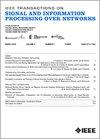从多个观察中发现社区:从产品图模型到大脑应用
IF 3
3区 计算机科学
Q2 ENGINEERING, ELECTRICAL & ELECTRONIC
IEEE Transactions on Signal and Information Processing over Networks
Pub Date : 2025-02-11
DOI:10.1109/TSIPN.2025.3540702
引用次数: 0
摘要
提出了一种基于多个观测值的社区检测多层图模型。当使用不同的估计器从节点上的信号推断图边缘时,或者进行各种信号测量时,这种情况很常见。多层网络在不同层堆叠这些图的观察结果,并在相邻层链接复制节点。此配置对应于基础真值图和路径图之间的笛卡尔积,其中节点的数量与观测值的数量相匹配。利用笛卡尔多层网络的拉普拉斯算子的代数结构,推导出真图的特征向量子集,并进行群体检测。在合成图上的实验结果证明了该方法的准确性,在正确检测图群方面优于目前最先进的方法。最后,我们将该方法应用于运动图像实验中采集的真实脑电图数据中不同脑网络的区分。我们的结论是,当多个图形观测可用时,我们的方法很有希望识别图形社区,并且它显示了基于脑电图的运动图像应用等应用的潜力。本文章由计算机程序翻译,如有差异,请以英文原文为准。
Community Detection From Multiple Observations: From Product Graph Model to Brain Applications
This paper proposes a multilayer graph model for community detection based on multiple observations. This scenario is common when different estimators are used to infer graph edges from signals at the nodes, or when various signal measurements are taken. The multilayer network stacks these graph observations at different layers and links replica nodes at adjacent layers. This configuration corresponds to the Cartesian product between the ground truth graph and a path graph, where the number of nodes matches the number of observations. Using the algebraic structure of the Laplacian of the Cartesian multilayer network, we infer a subset of the eigenvectors of the true graph and perform community detection. Experimental results on synthetic graphs demonstrate the accuracy of the method, which outperforms state-of-the-art approaches in correctly detecting graph communities. Finally, we apply our method to distinguish between different brain networks derived from real EEG data collected during motor imagery experiments. We conclude that our approach is promising for identifying graph communities when multiple graph observations are available, and it shows potential for applications such as EEG-based motor imagery applications.
求助全文
通过发布文献求助,成功后即可免费获取论文全文。
去求助
来源期刊

IEEE Transactions on Signal and Information Processing over Networks
Computer Science-Computer Networks and Communications
CiteScore
5.80
自引率
12.50%
发文量
56
期刊介绍:
The IEEE Transactions on Signal and Information Processing over Networks publishes high-quality papers that extend the classical notions of processing of signals defined over vector spaces (e.g. time and space) to processing of signals and information (data) defined over networks, potentially dynamically varying. In signal processing over networks, the topology of the network may define structural relationships in the data, or may constrain processing of the data. Topics include distributed algorithms for filtering, detection, estimation, adaptation and learning, model selection, data fusion, and diffusion or evolution of information over such networks, and applications of distributed signal processing.
 求助内容:
求助内容: 应助结果提醒方式:
应助结果提醒方式:


